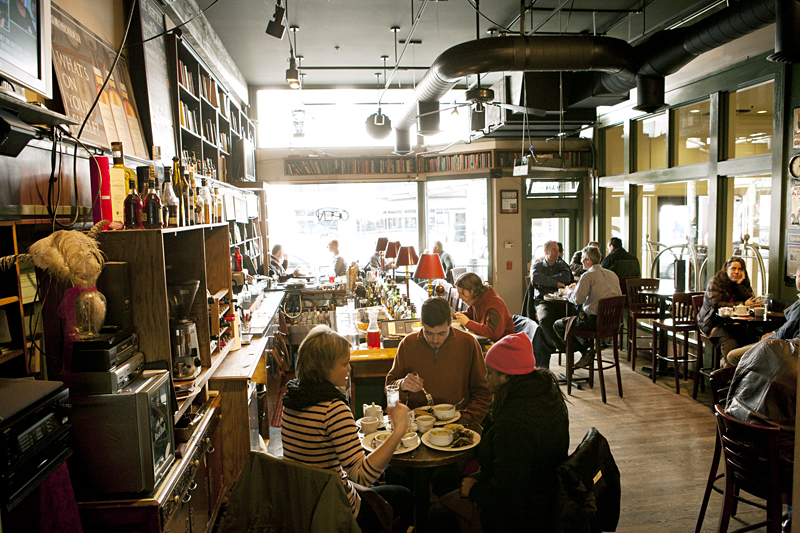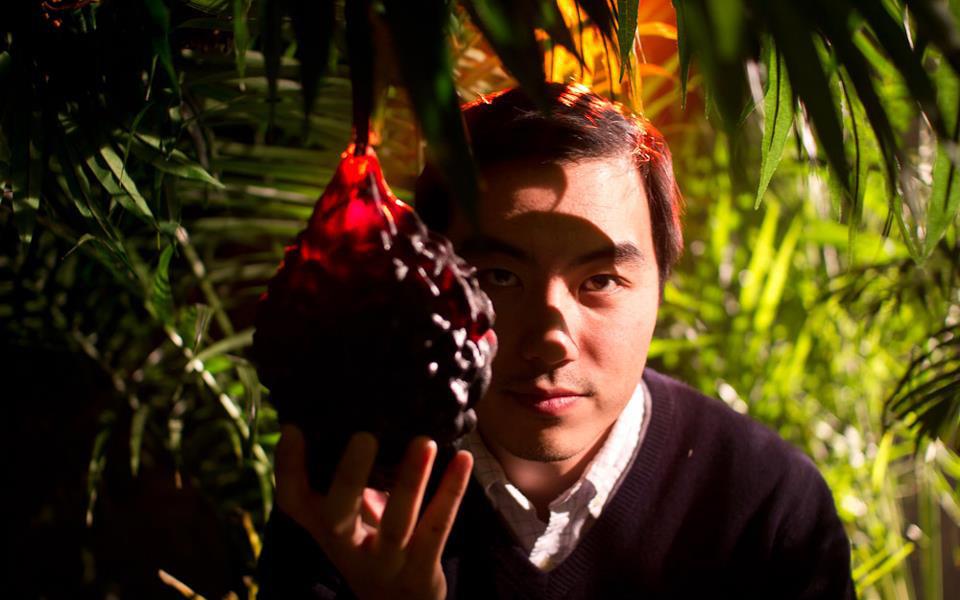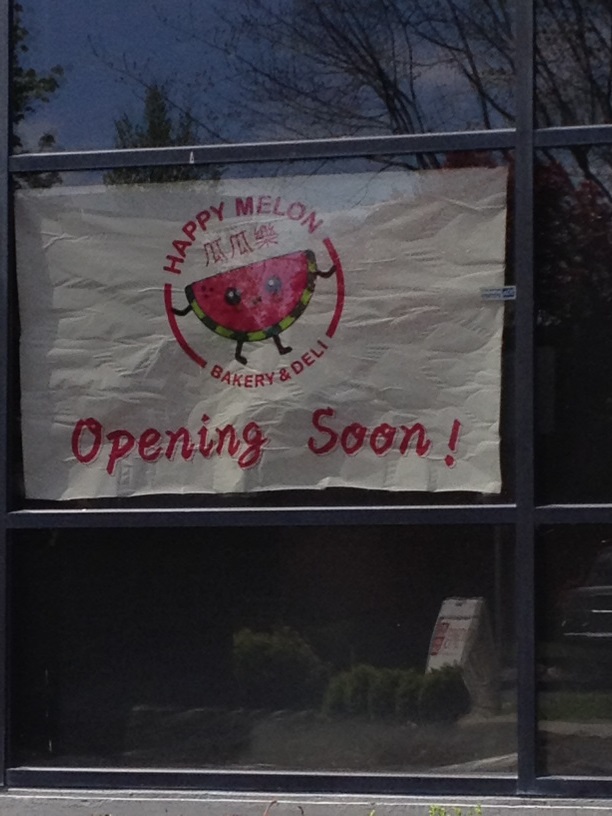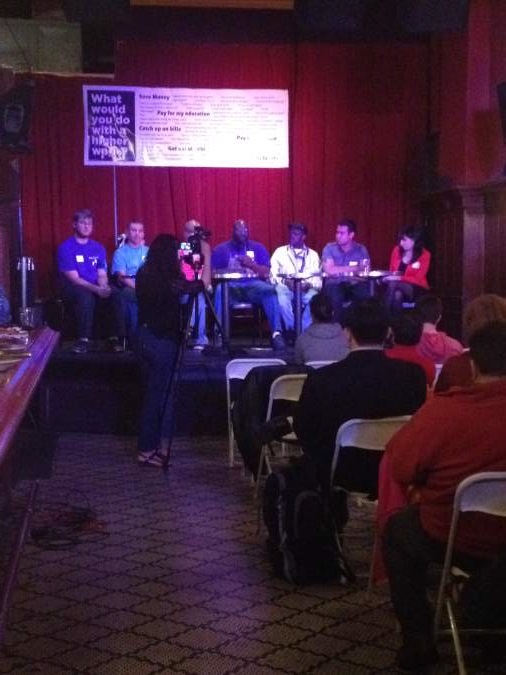Las Vegas is supposed to tempt and torment—not educate— the jackpot aspirants who book vacations there. Instruction is usually best left to cities where gift shops can legitimately sell tin fifes and quill pens. But for at least a decade or two now, Sin City has functioned as a secondary school for serious eaters, exposing inhabitants of fine-dining wastelands to the art of saucing and the science of sous vide. Vegas has taught its visitors sundry culinary secrets—for example, that a restaurant housed in a hotel has more to offer than bland room-service fare delivered a very short distance.
Many hotels which once operated kitchens as an afterthought now pride themselves on their extraordinary restaurants, serving meals that rival the cost of a night’s stay. Interestingly, the Alexis Hotel is traveling against the flow of traffic, transitioning over its history from an intimate dining room serving chanterelles and skate wing to a noisy pub that hosts weekly movie nights.
The Bookstore Bar, currently the only Alexis venue offering dinner, is just across the alley from Seattle Weekly‘s offices, but it took a movement of heaven and earth to get me there. Today is Leap Day, a calendar adjustment that occurs every four years to account for the extra hours the planet accumulates in its revolutions around the sun. The last year Leap Day fell on a Wednesday—meaning the last time we published on a Leap Day—was 1984. In addition to an editorial endorsing Gary Hart and quarter-page ads for sheepskin car-seat covers, our Feb. 29, 1984, issue included a review of The Alexis, the snazzy restaurant occupying the then-two-year-old hotel of that name.
“I would say I had a pleasant meal at the Alexis,” critic Schuyler Ingle wrote. “Several days later, I am still thinking about that meal, retasting the sauces, surprised that it is all still with me and not fading off into a haze of one more night on the town.”
Food writers today are more likely to arrive early for a reservation so they can check out a restaurant’s rooftop honey hives than beat a hazy exit from another evening spree in a car outfitted with sheepskin seats, but I wondered how our previous assessment of the Alexis’ cooking would hold up. Complicating my mission was the jittery nature of the Alexis’ dining program. In 1991 Seattle Times critic John Hinterberger declared “few places in town have gone through so many changes”—and that was two changes ago.
As best as the hotel’s publicist could reconstruct, the pink-walled Alexis Restaurant opened in 1982. It was a flop. In the span of a year, two chefs tried and failed to create a dining room worthy of a hotel angling for world-class status. In 1983 the Alexis hired Robin Sanders and Bruce Naftaly, now chef/owner of the soon-to-close Le Gourmand, to right the operation. “The restaurant was a disaster when we got there,” Naftaly said in 1984. “There were no systems in place.”
But systems couldn’t save the restaurant, which the Alexis eventually leased to McCormick and Schmick’s, already running a restaurant one block north that remains today. The chain renovated the space as a “Seattle-style steakhouse,” meaning the south wall was plastered with a mural of local celebrities. Somehow red meat and smiling faces didn’t do the trick either, so the Alexis surrendered, turning the elegant room into a breakfast-only spot, which survives as the Library Bistro. The hotel refocused its dinner attentions on the original restaurant’s bar, rechristened Cafe Alexis. Jerry Traunfeld was among the chefs charged with making it work.
In 1993, Cafe Alexis became The Painted Table. A decade later, it was again transformed into the Bookstore Bar. Bodybuilder David Hatfield, who had previously run restaurants in Bend, Oregon, was named executive chef last month.
The Bookstore Bar doesn’t look like it suffers from instability. Perhaps as a reaction to so many years of turmoil, the hotel has settled on a decorating scheme that emphasizes timelessness and permanence. As the name implies, the snug, dimly lit bar is surrounded by bookshelves stocked with endearingly ratty hardcovers and board games meant to be played.
The bar’s signature spirit is scotch, and so many brands are on offer that they don’t all fit behind the bar (a chorus line of whiskeys stands between the bartender and her customers). It’s best not to stray too far from brown liquor here: When I ordered a martini, which seemed like just the thing to drink while paging through a mid-century British mystery plucked from alongside my seat, it tasted as though it had been made with oxidized vermouth.
The drink was a disappointment, but didn’t qualify as a low point in a restaurant flush with them. I’d save that designation for an excruciatingly tough flank steak, served with a plop of gremolata and greasy fingerling potatoes as long and tender as lipstick tubes. The squared-off steak itself tasted like metal shavings and money wasted.
Or maybe the low point came on my second visit, when a single server was unfairly assigned the task of handling every table during happy hour. Happy didn’t describe the bartender, who explained she couldn’t take my drink order if I insisted on sitting at a table. When I asked whether a high-top near the bar counted as a table, thinking the restaurant might classify it as extended bar seating, she snapped: “What else would it be?” I returned to our table, still sporting the balled-up napkins, highball glasses, and ginger-beer bottles left by drinkers who’d departed 20 minutes ago.
When Ingle ate at the Alexis in 1984, his meal began with rosemary-cured beef. “The meat alone had authority, a dark, muscle flavor that quickly grew,” he wrote. “The cabernet underpinnings kept everything floating in air. The sauce acted as a complement to soften it up, giving the potency of the beef a splash of laughter.”
Currently, the meatiest starter at the Alexis is a pair of pulled-pork sliders slathered with a brown-sugared sauce and served on firm dinner rolls. It’s a decent happy-hour choice, as are the French fries, matted with blue cheese and bacon confetti. Crab cakes fried to a corn-dog finish are not.
For his entrée, Ingle had roast pheasant, which was spoiled for him by chanterelle mushrooms: “I have always found chanterelles to be one of the more overrated-but-we’re-too-hip-to-admit-it foods being sold for outlandish sums of money,” he wrote. There’s no pheasant at Bookstore Bar, but there’s a fairly tender roasted chicken that outshines a dried-out salmon, which disassembled on my plate like a house of cards, and a clump of overcooked angel-hair pasta swamped with a canned-tasting tomato sauce.
As much as Ingle liked the braised rutabaga slivers in his salad and the goose fat in his squash soup, he ultimately wasn’t eager to return to the Alexis for dinner. “Possibly for brunch,” he allowed. That might be a wise approach today, since Hatfield is promising biscuits with French mornay gravy and housemade wild-boar sausage. While menu tweaks alone may not vault the hotel back atop local diners’ restaurant wish lists, future changes are nearly certain at the Alexis.
Price Guide
Blue fries $7
Pork sliders $11
Chicken $19
Salmon $28
Flank steak $28








